
People have always enjoyed feeding gulls, geese, ducks or swans at beaches and parks. Indeed, they feel they are doing the birds a big favor, helping them out. What they might not realize is that feeding these birds is detrimental to them and the environment in many ways. Please read on to learn more about the harmful effects of hand feeding waterfowl.
Birds Have Amazing Survival Skills
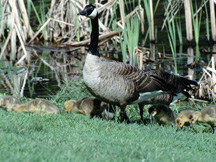
Waterfowl have an incredible ability to survive and avoid harsh weather conditions. They migrate hundreds of miles south to a warmer climate for the winter where food is abundant, or simply endure the harsh winter weather in northern areas. Many species of migratory and resident waterfowl spend the winter in Colorado. For all waterfowl, the abundance of naturally occurring food and the quality of their diet are the main driving forces behind the bird’s ability to survive.
Food Quality is Critical
Waterfowl require proper nutrition to survive Colorado winters. The diet of a young bird during its first year of life must be high in essential fats, proteins and nutrients to ensure proper development. Adults need a nutrient rich diet in order to replace feathers, and recondition their bodies after migration and during breeding cycles. People unknowingly harm waterfowl by hand feeding food that is low in nutritional value.
In fields, the Canada goose diet consists of fallen grain. In marshes, they feed on wild rice, sedges, other aquatic plants, insects, larvae, crustaceans and small mollusks. Their feeding habits are very regular and they are known to return day after day to the same location if they are not disturbed. Canada geese will feed on newly sprouted lawns and established grass in urban areas.
A Diet of White Bread Can Actually Be Fatal To Waterfowl
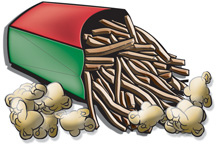
When birds feed on bread, they may stop eating natural food sources which are more nutritious. The birds may become malnourished and there have been cases of birds choking on wads of bread (Source: Ducks Unlimited).
High nutrition foods include: Insects, Grasses, and Submerged Aquatic Plants.
Low Nutrition foods include: Bread, Crackers, Popcorn, and Pastries.

Problems Associated With Feeding Waterfowl Include:
- Malnutrition
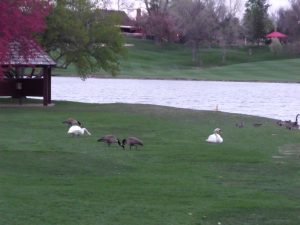
Canada geese, comfortable with swans. - Dependency
- Disease
- Water pollution
- Environmental degradation
- Increased hybridization
- Delayed migration
- Cumulative effects
- Costly management efforts
- Devaluation of the species
Let’s consider each in detail.
1. Malnutrition
Through evolution, wildlife species have developed skills to obtain food that contains the essential nutrients needed to survive, reproduce and live a healthy life. These skills help maintain a balance between animals and their natural habitat. This balance is compromised by hand feeding, which is physically harmful to birds and is one of the primary causes of malnutrition.
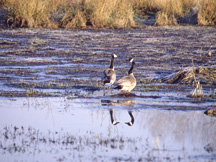
It would seem that providing food for ducks and geese would make them healthier. However, this is not the case. Waterfowl at artificial feeding sites are often found to suffer from poor nutrition. In natural settings, waterfowl seek and feed on a variety of nutritious foods such as aquatic plants, natural grains, and invertebrates. Many of the items commonly used to feed waterfowl (bread, corn, popcorn, etc.) are low in protein and are very poor substitutes for natural foods.
Natural foods are also widely scattered. Ducks and geese are able to find these foods and eat them in relative seclusion. At artificial feeding sites, competition for each scrap or kernel is high. Some ducks and geese (usually the youngest) are unable to compete for handouts.
Visible symptoms of poor nutrition and advanced stages of starvation are often seen at artificial feeding sites. For example, waterfowl may have drooping wings or may lose their ability to fly.
Malnutrition leads to:
- Low energy and muscle deterioration.
- Development of deformed wings in young birds.
- Loss of flight later in life.
- Lowered ability to avoid predation.
- Decrease in successful reproduction.
- Lowered life expectancy.
2. Dependency

Waterfowl, particularly Canada geese and mallards will congregate in areas with abundant food and space. Unfortunately, hand feeding can cause birds to become concentrated in small urban areas that are incapable of supporting large numbers of birds. The birds then become dependent upon humans for food an can become nuisance animals. Some birds can become aggressive and may need to be removed.
Geese are territorial birds and will not hesitate to protect their nest and eggs from a human or house pet they see as a threat. An aggressive adult goose can easily knock down a child or senior citizen, and geese can fly up to 50 mph. An aggressive goose will hiss at you and rear its head and then perhaps charge. Geese will fly up and hit a human, cat or dog in the face. This is especially likely if the goose has nested in a place near human traffic, including a parking lot or shrubbery near a building.

Artificial feeding often attracts birds to human habitats, parking lots, fast-food restaurants, and retention ponds, where they are more subject to accidental death. Natural cover, which can provide protection from bad weather and predators (even dogs and cats), is often lacking at these feeding sites.
Waterfowl can rapidly become conditioned to, and dependent on, handouts. Fed ducks and geese behave differently. They become more aggressive and eventually lose their wariness of humans. Some will not survive because they can’t compete. Many will lose the quality which endears them to most of us, their wildness.
Dependence upon humans for food causes:
- Loss of their natural fear of humans, which creates aggressive behavior.
- Concentration of birds near highways and airports, potentially causing motor vehicle and airplane accidents.
- Overpopulation of small wetlands and ponds.
- Delay or halting of migration to natural wintering or nesting sites.
3. Disease
Lowered nutrition and overpopulation allow disease to spread more quickly, potentially infecting thousand of birds with fatal diseases such as Avian Cholera, Duck Plague, Avian Influenza and Avian Botulism. Although these disease have always existed in waterfowl populations, the risks from the diseases increase when populations become concentrated at feeding sites.

When ducks and geese feed on scattered corn or bread, they eat in the same place where they defecate. Not healthy. In addition, large concentrations of waterfowl would facilitate the spread of disease. Also not healthy. Diseases generally not transmissible in a wild setting find overcrowded and unsanitary conditions very favorable.
An infected bird may spread the disease to many other birds by infecting the water supply. When the birds are scattered over a large area this does not pose a serious problem. However, when the birds are bunched close together, their chances of contracting disease increase and the result may be disastrous.
Canada goose feces contain disease-causing organisms which include salmonella, giardia and cryptosporidium. While there are no proven links of human illness from exposure to the droppings from Canada Geese, some dogs seem to be particularly susceptible to giardia. You should keep your dog from snacking on goose droppings while out on walks.
Most waterfowl die-offs in the past 10 years have involved artificial feeding:
- 2,000 mallards and black ducks were killed in an outbreak of Duck Virus Enteritis in Central New York.
- Another fatal disease, Aspergillus, occurs when food is scattered too liberally. It piles up and becomes moldy.
- In Cheektowaga, New York, hundreds of ducks were killed in an outbreak of Avian Botulism at a feeding site.
4. Environmental Degradation

Waterfowl naturally congregate in wetlands, when and where natural foods are plentiful. However, when hand feeding occurs, the over-concentration of birds may ultimately cause overgrazing and degradation to the landscape.
Feeding attracts birds in unnatural numbers, beyond natural food and water supplies, and frequently in numbers beyond what people will tolerate. Over-grazed and badly-eroded lawns, golf courses, and school playing fields are often the result of overcrowding. Grassy areas such as ball fields and golf courses can become unsanitary and unusable. Some parks have been forced to close down until goose droppings could be cleaned up, which can be quite costly.
- High concentration of birds cause:
- Overgrazing of vegetation, leading to soil erosion.
- Degradation of the landscape, making it undesirable for other species and unsightly for humans.
- Unsanitary conditions due to large quantities of bird feces.
5. Water Pollution
People will often feed Canada geese or ducks at the local pond or lakeside beach. This not only causes a nuisance situation with birds begging for and stealing food, but also contributes significantly to water pollution in the form of fecal coliform bacteria.
As a direct consequence of the concentration of this organic matter, water quality suffers from the excess nitrogen that subsequently runs off the land during the usual storm events. Too many nutrients in the water then leads to an overgrowth of algae, called an “algae bloom,” which blocks sunlight from entering the water and, thereby, adversely affects fish and other organisms in the aquatic environment.

Vegetation around the immediate feeding site is also impacted, because the overabundant waterfowl pull up the grass, trample the banks and otherwise damage the plants in adjacent habitat And where waterfowl congregate to feed, E-coli counts can swell to levels that make the water unsuitable for swimming.
Feeding the ducks and Canada geese can:
- Cause them to become a nuisance by begging and stealing food and garbage.
- Can cause unnatural amount of water contamination, leading to algal blooms, and the death of fish.
6. Increased Hybridization
At many feeding sites, domestic geese have interbred with Canada geese, further compromising the wild population.

7. Delayed Migration, No Migration
Feeding alters normal migration patterns of waterfowl by shortening or even eliminating them. Ducks, reluctant to leave in the winter, may not survive sudden cold. If the artificial feeding is stopped in time, ducks and geese can quickly adapt to finding natural foods and will follow their companions north. In West Haven, Connecticut, 30 swans died from starvation at an artificial feeding site during the harsh winter of 93–94. Meanwhile, over 800 swans survived nearby on natural food.
8. Overcrowding In Unnatural Sites
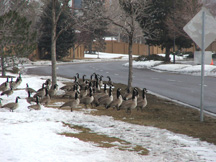
Feeding attracts birds in unnatural numbers, beyond natural food and water supplies, and frequently in numbers beyond what people will tolerate. Over-grazed and badly-eroded lawns, golf courses, and school playing fields are often the result of overcrowding. Grassy areas such as ball fields and golf courses can become unsanitary and unusable. Recreational areas have been forced to close down until goose droppings could be cleaned up.
Artificial feeding often attracts birds to human habitats—parking lots, fast-food restaurants, and retention ponds—where they are more subject to accidental death. Natural cover, which can provide protection from bad weather and predators (even dogs and cats), is often lacking at these feeding sites.
9. Costly Management Efforts
Many damage-avoidance techniques such as chemical repellents, fencing, or noise makers are costly and may even be useless once animals lose their fear of humans. At times, it is necessary to destroy nuisance waterfowl because of the damage they cause.
10. Devaluation
From treasure to nuisance… wildlife managers recognize that the public’s perception of the value of wildlife is often reduced when numbers swell. When any wildlife population exceeds the number that can be naturally supported by available habitat, this can polarize the public and exaggerate conflicts between landowners who suffer damage and those who visit the site to feed the geese and ducks.
Help Keep Our Wild Waterfowl Wild!

It may be hard to imagine that a handful of bread or a stray french fry could contribute to such a growing problem. Compound that, though. In most cases where artificial feeding occurs, one well-intentioned feeder leaves and another soon arrives.
If you care for waterfowl, here is what you can do to help them retain their “wildness” and maintain their well-being.
Stop feeding them!
They don’t understand the problem; you do. Purchase a Federal Duck Stamp at post offices, many sporting goods stores, or National Wildlife Refuges or call 1-888-534-0400 to order by mail. Proceeds from the sale of these stamps are used to purchase wetland habitats that become a part of the National Wildlife Refuge System which provides habitat for the conservation of our Nation’s waterfowl and other wildlife.
